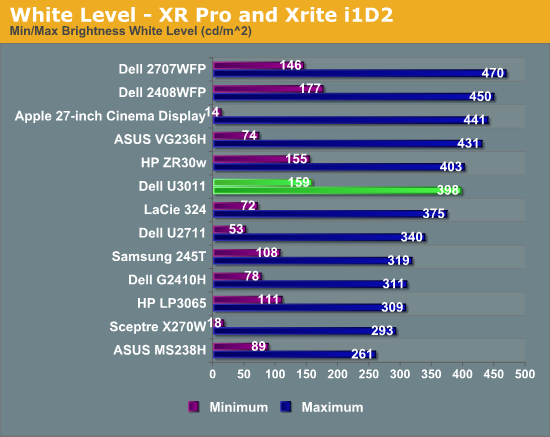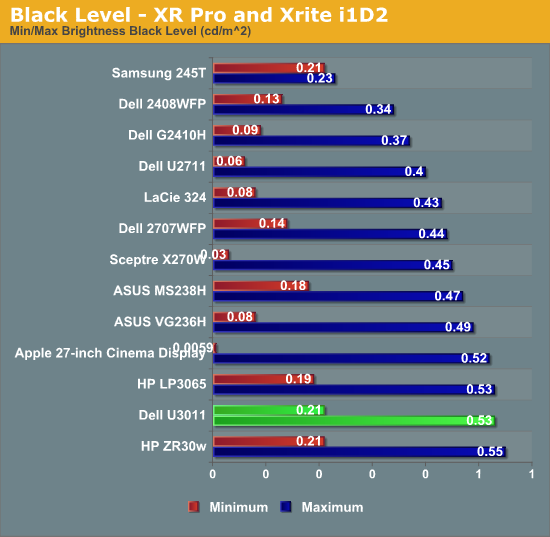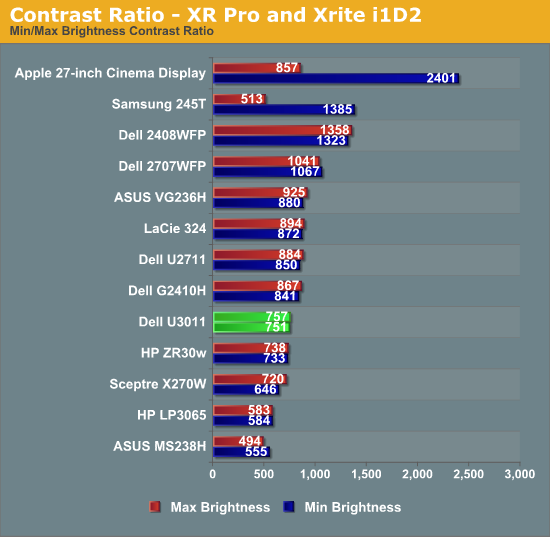Dell U3011 Review: Dell's New 30-inch Flagship
by Brian Klug on January 13, 2011 9:17 PM ESTBrightness and Contrast
For brightness we display white and black levels at maximum and minimum brightness as allowed by the OSD, and divide the two to get contrast. We use the same colorimeter described earlier. In this case, an Xrite i1D2 with ColorEyes Display Pro. For the U3011, dynamic contrast is turned off, contrast is set to maximum on the OSD, and the brightness control is varied across its possible dynamic range.



The brightness dynamic range on the U3011 isn't really amazing. In fact, it was a challenge to get the display to 100 nits for calibration (it required changing contrast and carefully balancing brightness and contrast controls on the OSD). One look at the contrast ratio plot however, and it's obvious what Dell did here - sacrifice dynamic range control for luminance but in so doing keep contrast extremely stable across that range of brightnesses. It's a tradeoff which actually makes a lot of sense, even if it isn't readily apparent when you're playing with the display, especially because the contrast OSD control visually makes a much larger difference than brightness which actually controls the CCFL power. I took a lot more data, but between max brightness and min brightness, contrast is pretty steady at around 750.
It's a bit unfortunate that the IPS in the U3011 isn't a bit more contrasty, especially when advertised is around 1000:1 with dynamic contrast off. Still, not bad.










123 Comments
View All Comments
InterClaw - Friday, January 14, 2011 - link
The Dell has input lag and the HP doesn't have sRGB... :( LG please save us prosumer/gamer types!Any word on a refresh of the not-so-pretty LG W3000H?
cjl - Friday, January 14, 2011 - link
As the owner of a U3011, I have to say, the input lag isn't bad. Yes, it measures as worse than the HP, but 20ms is really not noticeable to the vast, vast majority of people. It's not like the old 2408 for example, which was ~60ms if I remember right.Phoenixlight - Friday, January 14, 2011 - link
I don't understand your problem with 1920x1080, it's slightly wider than 1920x1200 but that's it. There's no reason to be against it. Games on my Alienware OptX AW2310 look great.snuuggles - Friday, January 14, 2011 - link
Agreed. If you don't game frequently, then fine, higher pixel pitch is great (though text scaling can be a problem as other posters have mentioned). But, *BUT*, if you mostly game, then high res is, at best, counter-productive - it basically forces you to either 1) use a non-native resolution or 2) scale *way* back on the graphical "goodies" or 3) spend $600 a year on GPUs.I'd really like it if there was some focus on stuff that *matters* for gaming:
- input lag
- pixel response
- refresh rate
resolution, color pallet, viewing angle etc are great, and I'll take em', but not when it sacrifices the ability of the display to resolve moving images quickly.
And, before you say it, I *would* just use a HDTV, except those are, on the whole, pretty junky, have terrible input lag, and are prone to "panel lottery" (where the manufacturer swaps out panels to save money but doesn't use a different model number. How is that even legal, btw?)
DanNeely - Friday, January 14, 2011 - link
They write the specs for it to have the lowest value for each panel of the right size; that way all of them meet the described specs on the product sheet and they can swap without worrying about false advertising claims.snuuggles - Saturday, January 15, 2011 - link
You're right, it's clear that what they are doing is legal. But as long as they don't specify stuff like input lag *at all*, even if you wait for a review to tell you this value, the manufacturer can, and often does, swap out a new, lower-performing panel.DanNeely - Sunday, January 16, 2011 - link
This is the 1st I've heard of input lag varying by panel make. I thought it was entirely due to the image processor used for overdrive/etc modes.DanNeely - Saturday, January 15, 2011 - link
The lower vertical resolution sucks for trying to do any real work on it.TegiriNenashi - Saturday, January 15, 2011 - link
Slightly wider? It's shorter!snuuggles - Saturday, January 15, 2011 - link
@DanNeely and TegiriNenashi,You are both right, I think the extra 120 pixels is both useful *and* not a huge burden on frame-rate. I was mostly thinking of the 2560x[whatever] resolutions that are real frame-rate killers.
I guess I'm just willing to accept the loss since I really don't do a huge amount of work on this computer - mostly gaming as I said, so 1080p is an acceptible compramise.